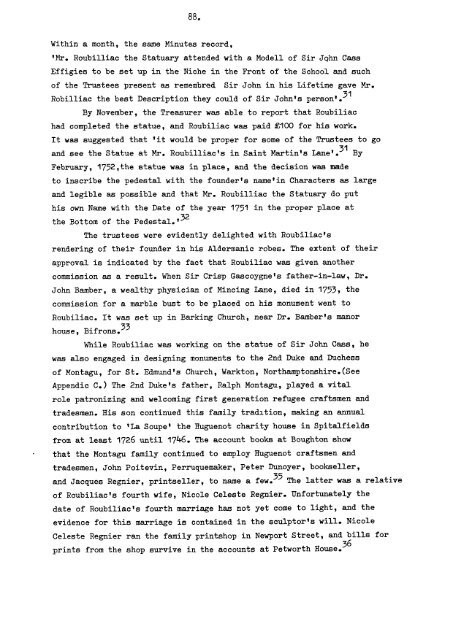HUGIJENOT ARTISTS DESIGNERS AND CRAYPSNEN IN GREAT ...
HUGIJENOT ARTISTS DESIGNERS AND CRAYPSNEN IN GREAT ...
HUGIJENOT ARTISTS DESIGNERS AND CRAYPSNEN IN GREAT ...
You also want an ePaper? Increase the reach of your titles
YUMPU automatically turns print PDFs into web optimized ePapers that Google loves.
88.<br />
Within a month, the same Minutes record,<br />
'Mr. Roubilliac the Statuary attended with a Modell of Sir JQhn Cass<br />
Effigies to be set up in the Niche in the Front of the School and such<br />
of the Trustees present as remembred. Sir John in his Lifetime gave Mr.<br />
Robilliac the best Description they could of Sir John's person'.31<br />
By November, the Treasurer was able to report that Roubiliac<br />
had completed the statue, and Roubiliac was paid f1OO for his work.<br />
It was suggested that 'it would be proper for some of the Trustees to go<br />
and see the Statue at Mr. Roubilliac's in Saint Martin's Lane'. 31 By<br />
February, 1752,the statue was in place, and the decision was made<br />
to inscribe the pedestal with the founder's name'in Characters as large<br />
and legible as possible and that Mr. Roubilliac the Statuary do put<br />
his own Name with the Date of the year 1751 in the proper place at<br />
the Bottom of the Pedestal.'32<br />
The trustees were evidently delighted with Roubiliac's<br />
rendering of their founder in his Aldermanic robes. The extent of their<br />
approval is indicated by the fact that Roubiliac was given another<br />
commission as a result. When Sir Crisp Gascoygne's father-in-law, Dr.<br />
John Bamber, a wealthy physician of Mincing Lane, died in 1753, the<br />
commission for a marble bust to be placed on his monument went to<br />
Roubiliac. It was set up in Barking Church, near Dr. Bamber's manor<br />
house, Bifrons.33<br />
While Roubiliac was working on the statue of Sir John Cans, he<br />
was also engaged in designing monuments to the 2nd Duke and Duchess<br />
of Montagu, for St. Edmund's Church, Warkton, Northamptonshire.(See<br />
Appendic C.) The 2nd Duke's father, Ralph Montagu, played a vital<br />
role patronizing and welcoming first generation refugee craftsmen and<br />
tradesmen. His son continued this family tradition, making an annual<br />
contribution to 'La Soupe' the Huguenot charity house in Spitalfields<br />
from at least 1 726 until 17k6. The account books at Boughton show<br />
that the Montagu family continued to employ Huguenot craftsmen and<br />
tradesmen, John Poitevin, Perruquemaker, Peter Dunoyer, bookseller,<br />
and Jacques Regnier, printseller, to name a few. 35 The latter was a relative<br />
of Poubiliac's fourth wife, Nicole Celeste Regnier. Unfortunately the<br />
date of Poubiliac's fourth marriage has not yet come to light, and the<br />
evidence for this marriage is contained in the sculptor's will. Nicole<br />
Celeste Regnier ran the family printahop in Newport Street, and bills for<br />
prints from the shop survive in the accounts at Petworth House.3°
















